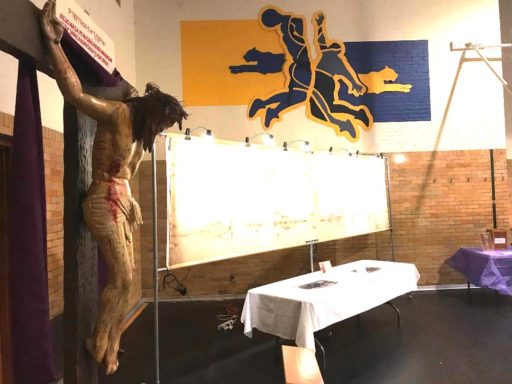Three Decembers ago, during the first week of Advent, I took my kids on a weekend trip to see their grandmother and my aunt and uncle. My aunt and uncle care for my grandmother, who was ninety-three at the time, and had recently started to lose her ability to speak.
We live only an hour’s drive away and wouldn’t be seeing them for Christmas, like we used to when I was a kid and everyone was young enough to sleep on the floor, so this quick visit was just to check in and say hello. My aunt says we’ll get pizza at Pizza Quick and let the kids play in the arcade, after that we’ll take them downtown to see Santa.
They live just outside Peru, Indiana, which at one time was known as the Circus Capital of the World because it used to serve as the winter headquarters for many circuses and other traveling acts; in fact, they live only a few miles from where the amateur circus still performs during the summer months.
To get to my grandmother’s, you turn right at the amateur circus onto Frances Slocum Trail, which must be one of the most illustrative stretches of two-lane highway you are likely to find in all of Indiana. Just a half mile down on the left is the childhood home of Cole Porter—I always whistle “Anything Goes” as I drive past—and a little farther beyond that, past the sloping drive for the Wabash Valley Coon Hunters Club, is the small faded sign for Seven Pillars overlook, a sandy turn-off where you can get out of your car and look down from the cliff bank into the Mississinewa River.
It’s a beautiful view in the fall, especially when the leaves are at peak color, but in December you have to use your imagination, as directly beneath your feet is the real attraction: a series of limestone pillars between which are shallow alcoves that the Miami people believed then (and now) are portals to another world.
Pizza Quick is busy and the kids drink Cokes and rack up stacks of tickets playing skee-ball that they cash in for Jolly Ranchers, off-brand Slinkys, and kazoos. My grandmother even takes a few turns at skee ball—my aunt standing at her elbow to steady her and hand her the wooden balls.
As we pull on our coats to leave, my aunt mentions that the old St. Charles parish school is hosting a traveling Shroud of Turin exhibit. She says, “It’s not the ‘real’ shroud, you know, but a copy.” This is exactly the kind of dissonance I need as a buffer against the mercantilism of the season. We find the Shroud in a corner of the school gym, positioned between a life-size crucifix and an even larger than life mural of two leaping basketball players rendered as blue and gold silhouettes. The yellowed cloth of the shroud is pulled taut between two metal poles, like a stretcher. Small lamps clipped to the top edge illuminate a pattern of faint brown stains. The lights are so bright that I have to squint to see the ghostly face of a bearded man lying in repose, clasped hands resting on his stomach.
From what I’ve read, the “real” shroud is almost certainly a forgery, but the accordion-like display that snakes back and forth across the basketball court and recounts the Passion of Jesus and the history of the Shroud is trying to convince me otherwise. I’m informed that a study by a team of scientists has found flaws with previous carbon dating attempts, and what’s more that the stains on the shroud contain immunoglobulin, hemoglobin, bilirubin, and albumin, all chemicals found in blood.
Despite my doubt, there’s something about the way the shroud glows, something about the particular rust color of the stains, something about the way my grandmother—sitting in one of the four chairs placed in front of the Shroud, stares up into the stained cloth—that causes me to weep.
I duck around the end of the display so that my kids will not see me, only to be confronted by a photograph of a life-size model of Jesus, back turned to the camera to reveal the effects of the scourge. The caption next to the photo tells me that it was created by a Monsignor Ricci “based on information derived from the study of the Shroud.”
As I stand there weeping, I am aware that what I am seeing has taken imagination: recreating the apostrophe-shaped tears that the scourge makes in the flesh; recreating with brush and paint the way the blood appears to weep from these wounds to create a red veil of gore. The word “Lacrimosa” springs into my mind: from the Latin “weeping” but also the last of Mozart’s compositions, or the last he worked on before his death.
I am recalling this word only because at the time my daughter was obsessed with Mozart, and had become a veritable encyclopedia of knowledge offering unsolicited trivia about him and other composers. Some people think he was writing his own funeral requiem, I remember her telling me. For him to die before completing the Requiem in D minor is one thing, but for him to die composing the Lacrimosa is “a mood.”
By the time I compose myself, and make obligatory small talk about the power of the exhibit with the old church lady sitting near the gym doors, it is fully dark. We drive the few blocks to see Santa, who we find by himself in a small shingled shack on the edge of the county courthouse lawn.
I don’t remember what Charlotte asked for, but I know that she was twelve and read from a list she had composed on a yellow legal tablet. I remember that Alex was eight and pale, thin and floppy haired. I remember that he sat half-heartedly on Santa’s lap and said he wanted Notre Dame to win a National Championship.
Back at my grandmother’s, we sat around the kitchen table and combed through boxes of photos that my aunt hauled up from the basement. There are hundreds of snapshots detailing the growth of my grandmother’s family: seven children ranging in age from 45 to 75. My aunt passes the photos one-by-one to my grandmother who takes them in her thin fingers. She gestures and points. She can say “yuh” and “nuh,” but that’s about it; even so, with my aunt as interlocutor, we are able to glean from the photos the names of great-great-grandparents and deceased and distant cousins, even the settings for photos that seem to lack any identifiable landmarks or landscape.
Among the numerous awkward yearbook portraits and documents of Christmas mornings past, we find something I’ve never seen before: a sepia-toned photo of my grandfather, headphones on, slumped against the wall of the radio room of a ship. I don’t know much about his service except that he was a Navy radioman on a ship somewhere in the Pacific.
Staring into this photograph, I notice his gaze is level and direct, and a slight impish smile plays on his lips, like he is attempting to send a message home: to make his presence felt across all that water, and all those miles, and all these years; and for a moment, it feels like he sees me.
It is then, for the second time that day, I begin to weep. I don’t even know why. Maybe it’s the few beers I’ve drank coupled with the stuffiness of the kitchen. My memories of him are few, but the one that comes to mind now is of a New Year’s Eve party sometime in the early eighties. He is standing in the living room wearing a glittery paper party hat and drunkenly telling the nativity stories of all his children. In all of them he is at work on the railroad when he receives the news. In a few, the gender of his newborn child is shouted to him above the rumble of engines idling in the trainyard.
Before we put the photos back in the box and call it a night, I take photos of as many as I can with my phone. I want to have them as proof, but also as aids to memory, so when I am feeling alone and untethered I might find my way back to this feeling: a feeling of thinness, of being on the bleeding edge of time where, as the poet writes, time present and time past / Are both perhaps present in time future…
Now my grandmother is dead. She died in October at the age of ninety-six. I am lucky to have visited with her several more times before her passing, but my most lasting memory of her will be of that day: playing skee ball; staring up into the ghostly face in the Shroud; holding the photo of my grandfather between her fingers, unable to tell me what she knows, but her face telling me everything.
Dave Griffith is the author of A Good War Is Hard to Find: The Art of Violence in America (Soft Skull Press). “Station VIII” is an excerpt from a 14-part text/sound collaboration with Kyle Peets inspired by the Stations of the Cross titled Days Between Stations. To listen to the audio collaboration click here.





